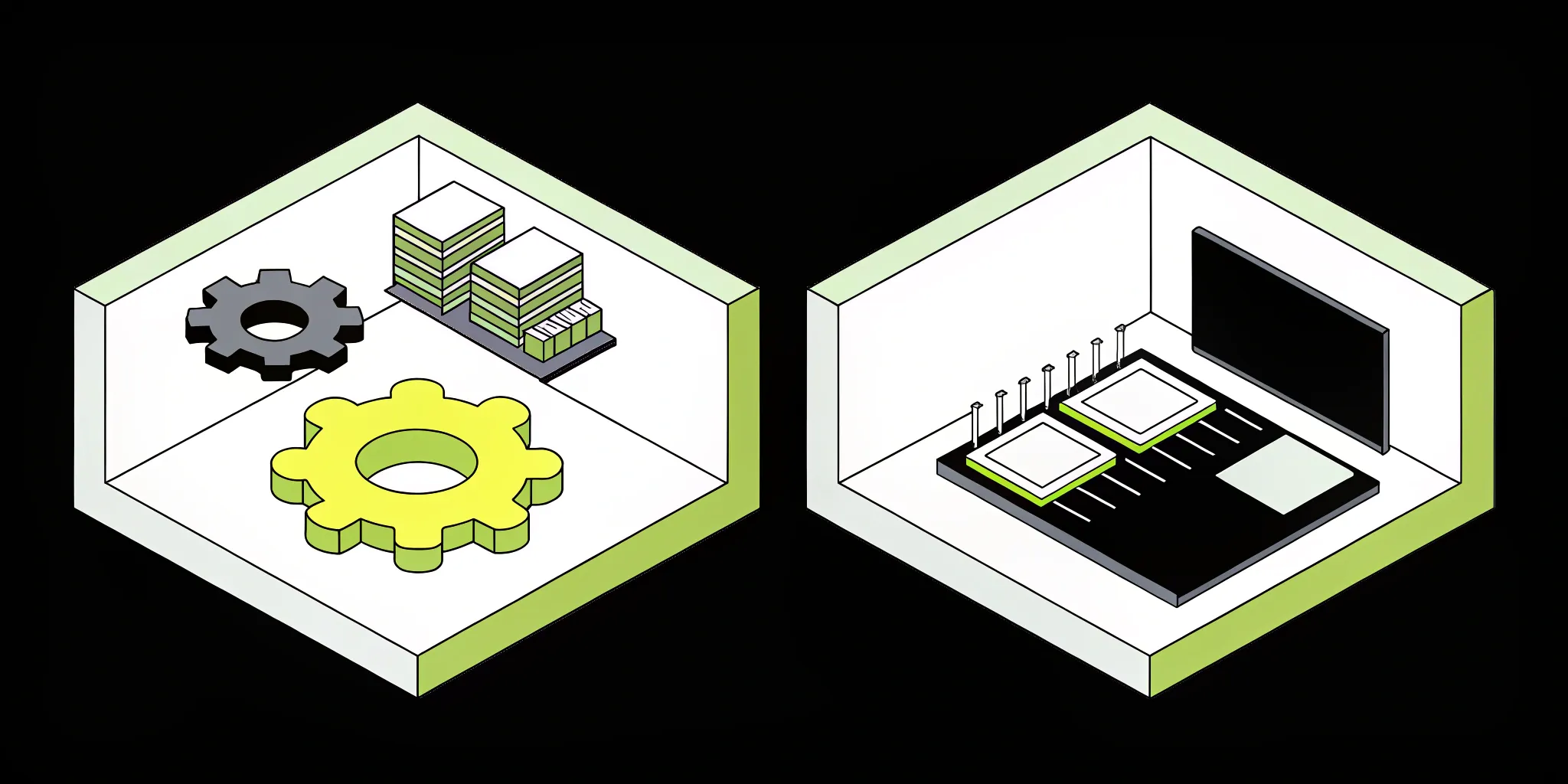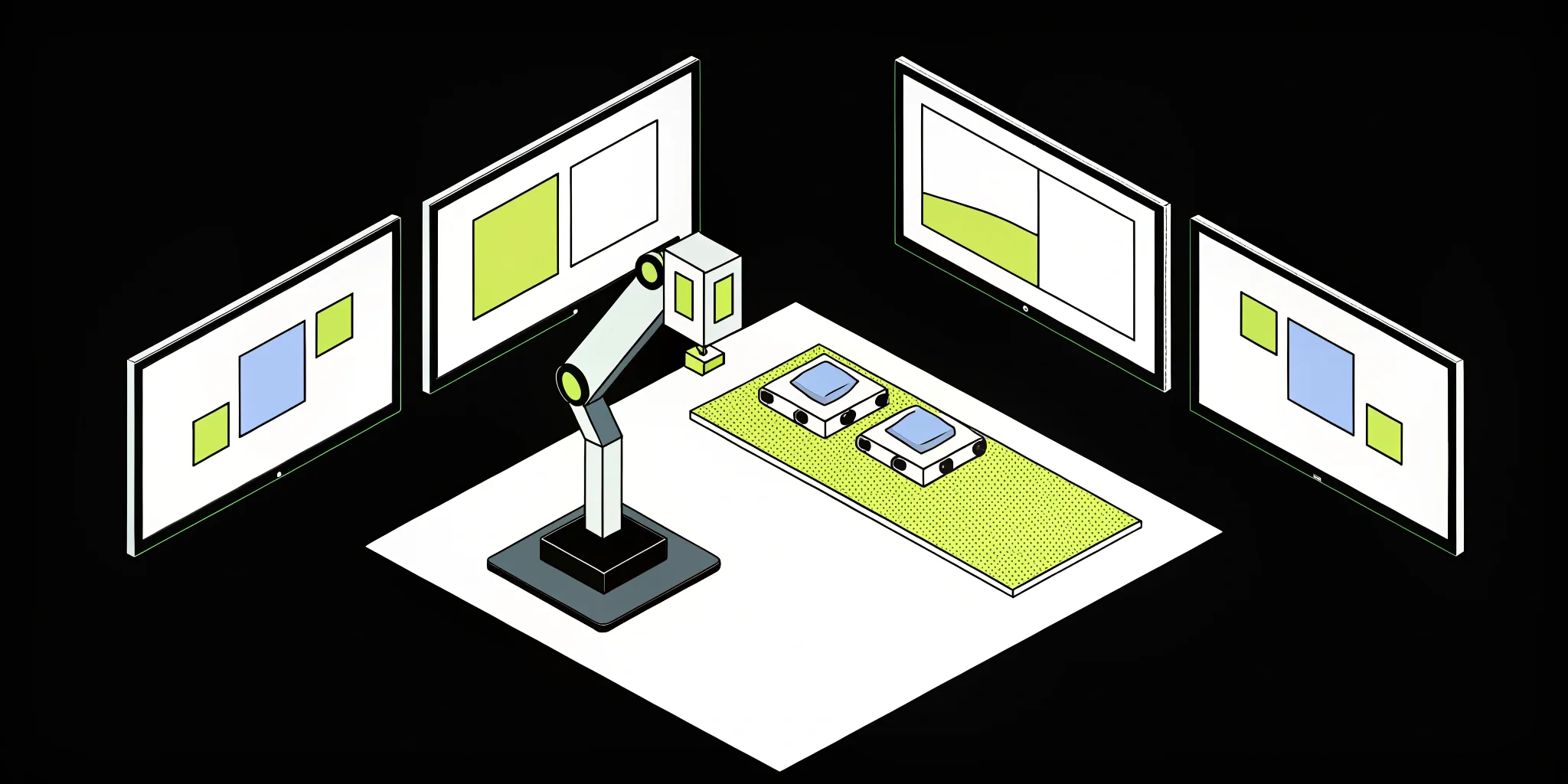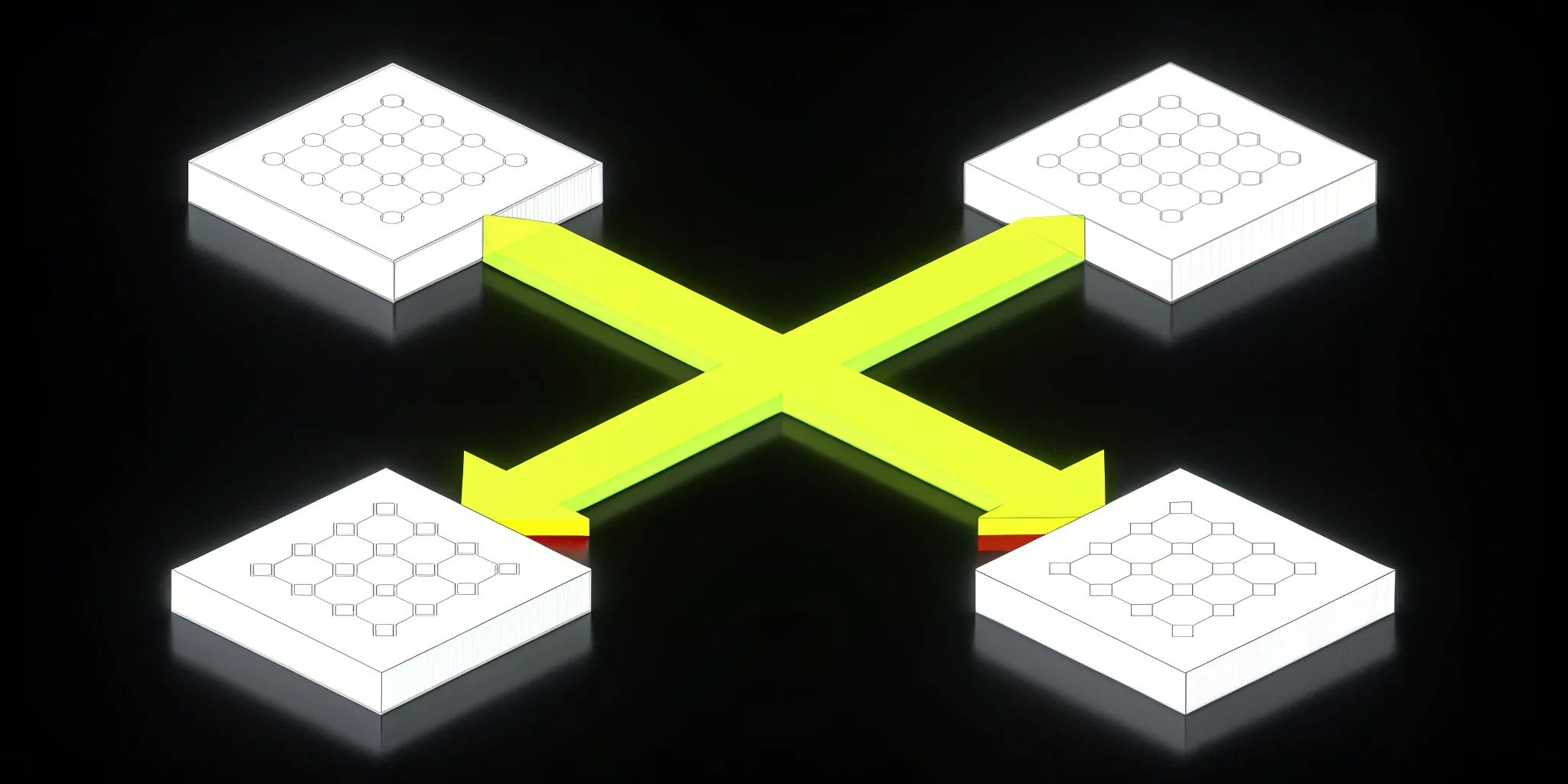MLOps vs. DevOps: Understanding the Key Differences

Your data science team just built a groundbreaking machine learning model. The potential is huge. But now comes the most common challenge: getting that model out of the lab and into a live production environment where it can actually deliver business value. This is where many promising AI initiatives stall, because the standard practices for shipping software just don't cover the complexities of ML. This gap is precisely where the MLOps vs DevOps conversation becomes critical. DevOps gives you a solid foundation for software delivery, but MLOps provides the specialized toolkit needed to deploy, monitor, and retrain models successfully over time.
Key takeaways
- Think beyond the code with MLOps: While DevOps focuses on application code and infrastructure, MLOps requires you to manage two extra, critical components: the data and the model itself. A successful AI project depends on tracking all three together.
- Plan for your models to change over time: Machine learning models aren't static; their performance can decline as they encounter new real-world data. MLOps provides the essential framework for monitoring this "model drift" and automatically retraining your models to keep them accurate and reliable.
- Master DevOps before moving to MLOps: You can't have effective MLOps without a solid DevOps foundation. MLOps extends DevOps principles to handle the unique challenges of machine learning, so establishing a mature CI/CD culture first is the key to getting your AI initiatives off the ground successfully.
What are MLOps and DevOps?
Before we get into the specifics, let's clear up the basics. You've probably heard both "MLOps" and "DevOps" thrown around, and it's easy to get them mixed up. While they share a similar name and philosophy, they're designed for different worlds. Think of MLOps as a specialized practice that grew out of DevOps to handle the unique needs of machine learning. Understanding both is the first step to building a solid foundation for your AI projects.
What MLOps is (and what it does)
Think of MLOps as DevOps, but specifically for machine learning. It applies the same principles of automation and collaboration to the entire lifecycle of an AI model—from development and training to deployment and monitoring. But MLOps has a special focus that DevOps doesn't: data. In the world of MLOps, data is a first-class citizen because the quality and consistency of your data directly impact how well your model performs. It’s a framework designed to manage the complexities of ML models, ensuring they are reliable, scalable, and continuously delivering value in production environments.
BLOG: MLOps explained
What DevOps is (and what it does)
DevOps, on the other hand, is focused on the traditional software development lifecycle. Its main goal is to streamline how we build, test, and release software by bringing development (Dev) and IT operations (Ops) teams together. By fostering a culture of collaboration and automating key processes, DevOps helps teams deliver high-quality software faster and more reliably. The practice manages artifacts like source code, binaries, and configuration files, ensuring that the path from a developer's keyboard to a live application is as smooth as possible. It’s the foundation that allows companies to release software updates frequently and with confidence.
Where their goals overlap
While they operate in different domains, MLOps and DevOps are built on the same core principles. Both aim to break down silos between teams, improve efficiency through automation, and create faster, more reliable deployment cycles. They both rely heavily on practices like continuous integration and continuous deployment (CI/CD) to automate testing and releases. You'll also find that both MLOps and DevOps workflows make extensive use of cloud technologies to get the scale and flexibility they need. MLOps essentially takes the successful playbook from DevOps and adapts it for the unpredictable, data-driven world of AI.
How do MLOps and DevOps differ in focus?
While MLOps and DevOps share the same goal of making development and deployment faster and more reliable, they concentrate on different things. Think of it like two chefs in the same kitchen: one is a baker focused on perfecting the bread, and the other is a saucier focused on creating the perfect sauce. Both contribute to the final meal, but their ingredients and techniques are distinct. DevOps is centered on the application and its supporting infrastructure, while MLOps is built around the unique lifecycle of machine learning models and the data that fuels them. This fundamental difference in focus shapes their entire processes, from initial development to long-term maintenance.
The focus of DevOps: Applications and infrastructure
DevOps is all about streamlining the path of traditional software from a developer’s keyboard to a live production environment. Its primary focus is on the application code itself. The main goal is to foster collaboration between development and operations teams to automate and speed up the software delivery pipeline. This means building, testing, and releasing software updates more frequently and reliably. The core components are the application code and the infrastructure it runs on. Success in DevOps is measured by things like deployment frequency, lead time for changes, and application uptime. It’s a mature practice designed to make software development predictable and efficient.
The focus of MLOps: Models and data
MLOps takes the principles of DevOps and adapts them for the highly experimental and data-dependent world of machine learning. You can think of MLOps as DevOps specifically for AI. Here, the focus expands beyond just code to include two new, critical components: models and data. In MLOps, data is treated as a first-class citizen because the quality of the data directly determines the performance of the ML model. The goal isn't just to deploy code, but to deploy a model that makes accurate predictions. This requires managing data versions, training models, and validating their performance in a continuous, automated loop.
Comparing their core processes
At a high level, both practices involve a loop of coding, validating, and deploying. However, the MLOps process is inherently more complex. While a DevOps pipeline tracks changes to the application code, an MLOps pipeline has to track much more: the code, the version of the dataset used for training, the model itself, and the specific parameters (hyperparameters) used to build it. Furthermore, monitoring in MLOps goes beyond just checking if an application is running. It involves constantly watching for model drift, which happens when a model’s predictions become less accurate over time because the new, real-world data it sees is different from its training data.
BLOG: Machine learning platforms: A practical guide to choosing
What unique challenges does MLOps address?
Machine learning isn’t like traditional software, so it comes with its own unique set of hurdles. While DevOps is great for shipping applications, MLOps is explicitly designed to tackle the experimental and data-dependent nature of ML models. It provides the framework to manage the entire lifecycle, from training to production and back again, addressing problems that standard software development practices don't account for. These challenges are precisely why a dedicated MLOps approach is so critical for any organization serious about getting real value from its AI initiatives.
Handling model performance over time
An ML model isn't a static piece of code; its performance can degrade over time. This happens because the real-world data it sees in production starts to look different from the data it was trained on. This phenomenon is known as model drift. For example, a model trained to predict sales trends before a major economic shift will likely become less accurate afterward. MLOps directly confronts this by implementing continuous monitoring to detect when a model's performance on new data begins to differ from its original training. When a dip in accuracy is detected, it can automatically trigger alerts or even kick off a retraining process to keep the model relevant and effective.
Managing data versions and quality
Unlike a typical software project where the main variable is code, an ML project has three moving parts: code, data, and the model itself. Without a system to track how these components interact, things can get messy fast. If a model in production starts making strange predictions, how do you trace the problem? Was it a change in the code, an issue with the new training data, or something else? This is a classic MLOps challenge that MLOps solves with rigorous version control. It doesn't just version code; it also versions datasets and models, creating a clear, auditable trail that makes it possible to reproduce any experiment or model build.
Retraining and validating models continuously
Because models drift and data changes, you can't just deploy an ML model and walk away. It needs ongoing maintenance to remain useful. MLOps formalizes this by creating an automated, continuous loop of retraining, validation, and deployment. Instead of being a manual, fire-drill-like event, retraining becomes a routine part of the model’s lifecycle. MLOps introduces critical steps for data handling and model validation that ensure only high-quality, effective models make it into production. This automated cycle is what transforms a promising experimental model into a reliable, long-term business asset that you can count on to deliver results.
How do MLOps and DevOps processes compare?
When you look at the day-to-day workflows, the differences between MLOps and DevOps become crystal clear. While they share a foundation in automation and collaboration, MLOps introduces a new layer of complexity centered around data and experimentation. Let's break down what each process looks like.
A look at the standard DevOps workflow
The standard DevOps workflow is a continuous loop designed to get high-quality software into the hands of users faster. It automates the path from writing code to deploying it in a production environment. Think of it as a well-oiled assembly line: developers write code, it's automatically built, tested for bugs, and then released. This cycle emphasizes close collaboration between development and operations teams to keep everything running smoothly. The primary goal is to make the software development lifecycle predictable, efficient, and reliable. A mature DevOps practice ensures that new features and fixes are delivered quickly without sacrificing stability.
How the MLOps workflow adds new steps
MLOps takes the DevOps foundation and builds on it, adding several steps unique to ML. Because ML models are built from both code and data, the process is inherently more complex. Before you even get to the coding part, you have to think about data. The MLOps workflow includes stages like data collection, validation, cleaning, and feature engineering. After that comes model training, evaluation, and validation before the model can be deployed. MLOps is a specialized subset of DevOps that accounts for this entire ML lifecycle, ensuring that both the data and the model are versioned, tested, and managed with the same rigor as the application code.
Why experimentation is key in MLOps
Unlike traditional software development, where the logic is explicitly coded, machine learning involves a process of discovery. This is where experimentation comes in. MLOps workflows are built to support continuous experimentation with different models, data sets, and hyperparameters to find the best solution for a problem. Each experiment needs to be tracked—what data was used, what parameters were set, and what was the resulting model performance? This iterative process is essential for not only building an effective model but also for improving it over time. Managing these experiments is a core challenge that MLOps solves, creating a structured environment for the creative, research-oriented work of data science.
CAKE SUCCESS STORY: "Like DevOps on Steroids"
Who makes up MLOps and DevOps teams?
The success of both DevOps and MLOps hinges on having the right people working together. While they share a foundation in engineering, the introduction of ML brings new experts into the fold. Understanding these team structures is key to figuring out which approach fits your project and what kind of talent you’ll need. Let's break down who you'll typically find on each team and how they collaborate.
The typical DevOps team structure
A standard DevOps team is a blend of development and operations expertise. At its core, you’ll find software engineers, who write application code, and DevOps engineers, who build and manage the infrastructure that runs it. Their world revolves around the application lifecycle—coding, building, testing, and deploying software efficiently. The main goal is to automate pipelines and shorten development cycles so that new features can get to users faster. This structure is perfect for traditional software development, where the primary focus is on the application code and the environment it lives in. The team works in a continuous loop to improve the product and its delivery.
How MLOps teams add data science experts
MLOps takes the DevOps foundation and builds on it by adding specialized data science roles. This is where you bring in the people who live and breathe data. An MLOps team typically includes data scientists, who are responsible for exploring data and building predictive models, and machine learning engineers, who then take those models and get them ready for production. They handle the complex process of deploying, monitoring, and maintaining the models in a live environment. You still have your DevOps and software engineers, but now they’re working alongside experts who understand the unique challenges of machine learning, from data validation to model retraining.
Making collaboration work between teams
The magic of MLOps happens when these diverse teams click. It’s all about creating a culture of collaboration between data scientists, developers, and operations specialists. While a data scientist might focus on model accuracy, a DevOps engineer thinks about system stability and scalability. MLOps creates a shared framework where everyone can work toward the same goal: delivering reliable, high-performing ML systems. Both MLOps and DevOps aim for greater efficiency through automation, but MLOps places a special emphasis on bridging the gap between data science and operations. A unified platform like Cake can be the glue that holds it all together, providing tools that help these different experts speak the same language.
What tools power MLOps and DevOps?
Both DevOps and MLOps rely on a set of specialized tools to automate and streamline their workflows. Think of it as having the right equipment for the job—while a hammer is useful, you wouldn't use it to saw a piece of wood. Similarly, while some tools overlap, each discipline has a core toolkit designed for its specific goals, whether that’s deploying an application or a machine learning model. Let's break down the go-to tools for each practice.
Common tools in the DevOps toolkit
The DevOps toolkit is all about enabling continuous integration and continuous delivery (CI/CD). These tools work together to help teams build, test, and release software faster and more reliably. You'll often find a combination of tools that manage everything from code to infrastructure. Some of the most popular ones include Jenkins for automating builds, Docker for packaging applications into containers, and Kubernetes for managing those containers at scale. Another key player is Terraform, which allows teams to define and manage their infrastructure as code, making setups repeatable and consistent.
Essential tools for the MLOps lifecycle
MLOps tools are built to handle the unique, cyclical nature of machine learning. They address challenges that don't exist in traditional software development, like tracking experiments, versioning massive datasets, and monitoring model performance after deployment. Key tools in this space include MLflow, an open-source platform for managing the entire ML lifecycle from experimentation to deployment. You'll also see tools like DVC for data versioning, Kubeflow for running ML workflows on Kubernetes, and Apache Airflow for orchestrating complex data pipelines. These tools help data science and operations teams collaborate effectively.
The unique infrastructure ML needs
Machine learning requires a specialized and powerful infrastructure that goes beyond typical application hosting. Training a model can be incredibly resource-intensive, demanding powerful GPUs and the ability to process huge volumes of data. MLOps practices help automate the deployment of models onto this infrastructure, ensuring they run efficiently and reliably. This is crucial for making data-driven decisions and maintaining model performance over time. As organizations increasingly rely on complex data, having robust MLOps practices becomes essential for turning AI investments into real business value, which is where a managed platform can make all the difference.
How do MLOps and DevOps handle testing and monitoring?
Once a product is live, both DevOps and MLOps teams shift their focus to testing and monitoring to ensure everything runs as expected. However, what they’re looking for is quite different. While a DevOps team asks, “Is the application stable and performing well?” an MLOps team asks, “Is the model still accurate and making reliable predictions?” This fundamental difference in questioning leads to distinct approaches for keeping systems healthy and effective in production.
Testing and monitoring in a DevOps world
In a DevOps environment, testing and monitoring are all about the health and performance of the application and its underlying infrastructure. Teams use various tools to track metrics like server uptime, CPU usage, response times, and error rates. The main goal is to ensure the software is available, fast, and free of bugs. If a new code deployment causes the application to crash or slow down, the monitoring system will raise an alert, and the team can quickly roll back the change. It’s a straightforward process focused on maintaining operational stability for the end user.
Model validation and performance tracking in MLOps
MLOps takes monitoring a step further. It’s not enough for the model to simply be running; it must also be accurate. MLOps teams track a model’s predictive performance using statistical metrics, but they also watch for a unique problem called model drift. This happens when a model's accuracy gets worse over time because the new, real-world data it sees is different from the data it was trained on. To manage this, MLOps involves rigorous tracking of data versions, model versions, and hyperparameters. This detailed record-keeping is essential for troubleshooting, auditing, and ensuring that the model’s predictions remain trustworthy.
How MLOps supports continuous learning
Because models naturally degrade, MLOps is built around the idea of continuous learning and improvement. Monitoring isn't just about catching problems; it's about feeding information back into the development cycle. When MLOps tools detect that a model’s performance is slipping, it triggers a process to retrain the model on new data. This workflow includes experimenting with different algorithms and features to find a better-performing version. MLOps automates this entire cycle of retraining, validating, and redeploying models, creating a system that doesn't just maintain itself but actively gets smarter over time.
MLOps automates this entire cycle of retraining, validating, and redeploying models, creating a system that doesn't just maintain itself but actively gets smarter over time.
How to succeed with MLOps and DevOps
Getting started with MLOps and DevOps doesn't have to be complicated. Success comes from building the right foundation and understanding which approach fits your projects. By focusing on a few core principles, you can create a smooth, efficient workflow that brings your software and machine learning models to life.
Follow these best practices
To set your teams up for success, it helps to follow a few key guidelines. Think of these as your starting playbook. First, establish a strong DevOps foundation before you even think about layering on MLOps. Next, make sure you’re using the right tools for the job, especially for things like data versioning and managing your models. Finally, you’ll want to regularly monitor your models for any performance drift. Models can become less accurate over time as new data comes in, so keeping an eye on them and retraining when needed is crucial for maintaining their value.
Do you need MLOps, DevOps, or both?
This is a common question, and the answer is pretty straightforward. If your company is working with artificial intelligence and machine learning, you absolutely need MLOps. If you aren't, then a solid DevOps practice is likely all you need. The choice really comes down to what you’re building. If your focus is on broader software development and delivery, DevOps is perfectly suited for your goals. But the moment you introduce ML models into your applications, MLOps becomes essential to manage their unique lifecycle. It’s not about choosing one over the other; it’s about aligning your strategy with your operational needs.
Why a strong DevOps practice is the first step to MLOps success
You can’t have successful MLOps without solid DevOps. It’s that simple. Many companies struggle to adopt MLOps because they haven’t first established a mature DevOps culture and toolset. MLOps extends DevOps principles to handle the specific challenges of machine learning, so you need that base to build upon. Think of DevOps as the foundation and MLOps as the specialized framework you build on top of it. Without that strong base, your MLOps initiatives will have a hard time getting off the ground. This is where a comprehensive solution that manages the entire stack can help you accelerate your AI initiatives by ensuring the right foundation is in place from the start.
How are MLOps and DevOps evolving?
Neither DevOps nor MLOps exists in a vacuum. Both fields are constantly adapting to new technologies and business demands. As software becomes more complex and AI becomes more integrated into everyday applications, these two disciplines are not only evolving on their own but are also growing more interconnected. Understanding their trajectory can help you see where your own processes need to head next.
What's next for DevOps
DevOps continues to focus on its core mission: streamlining the entire software development lifecycle to deliver applications faster and more reliably. The field is constantly refining its practices, with a growing emphasis on integrating security earlier in the process (often called DevSecOps) and tying deployment metrics directly to business outcomes. As this happens, DevOps is also becoming the foundation for more specialized areas. MLOps is a perfect example—it’s a specialized subset of DevOps that adapts its proven principles to the unique world of machine learning models.
Why MLOps is becoming so important
As more businesses invest in AI, they’re running into a common roadblock: getting models out of the lab and into the real world. MLOps has emerged as the critical practice that makes this possible. It provides the framework to deploy, monitor, and maintain ML systems efficiently, ensuring they deliver actual business value. Think of it this way: MLOps brings the power of continuous integration and continuous delivery (CI/CD) to machine learning. This allows organizations to operationalize ML at scale, turning promising models into reliable, production-ready applications.
How the two fields are coming together
MLOps doesn’t replace DevOps; it builds on top of it. It takes the core DevOps principles of automation, collaboration, and iteration and extends them to address the specific challenges of the machine learning lifecycle. The two fields are converging around a shared culture. At their heart, both MLOps and DevOps are about breaking down silos and fostering collaboration between teams, whether it’s developers and IT operations or data scientists and software engineers. This shared emphasis on continuous improvement and experimentation is what allows organizations to build a cohesive strategy that supports both traditional software and advanced AI systems.
What skills do you need for MLOps and DevOps?
Building successful teams in either DevOps or MLOps comes down to having people with the right mix of skills. While the two fields are closely related, they require different areas of expertise. DevOps is centered on the software development lifecycle, while MLOps extends those principles to the unique, experimental world of ML. Understanding the distinction is crucial for any business looking to streamline its AI initiatives.
For organizations, identifying these skill sets is the first step toward building a capable team. It informs your hiring strategy, helps you design effective training programs, and clarifies which roles you need to fill. Whether you're a professional looking to grow your career or a leader building a team from scratch, knowing what to focus on is key. The ultimate goal is to create a collaborative environment where software engineers, operations specialists, and data scientists can all work together seamlessly. This synergy is what gets reliable, high-performing applications and models into production faster, turning AI concepts into real business value. A platform like Cake can manage the underlying infrastructure, allowing your team to focus on developing these core competencies and delivering results.
Key skills for a career in DevOps
A career in DevOps is built on a foundation of strong software engineering principles combined with an operations mindset. Since the core goal is to bridge the gap between development and operations, communication and collaboration are non-negotiable soft skills. On the technical side, you need a solid grasp of version control systems like Git to track code changes and manage project artifacts.
Proficiency in scripting and automation is also essential for building and maintaining CI/CD pipelines. You’ll be expected to understand cloud computing platforms and infrastructure as code (IaC) tools. The primary roles in DevOps are typically software and DevOps engineers who live and breathe these practices to improve the speed and quality of software delivery.
Must-have skills for a career in MLOps
MLOps takes all the core skills from DevOps and adds a thick layer of data science and machine learning expertise. Professionals in this field need a much deeper understanding of machine learning models, including how they are trained, validated, and deployed. This means you need to be comfortable with the entire ML lifecycle, not just the code that runs it.
Key skills include data engineering—knowing how to build and manage data pipelines—and meticulous tracking of everything from datasets and model versions to hyperparameters. Because model performance can degrade over time, you also need expertise in monitoring, validation, and setting up automated retraining workflows. This role is perfect for data scientists who want to operationalize their work or DevOps engineers fascinated by machine learning.
How to build skills across both areas
The good news is that skills in one area provide a fantastic launchpad into the other. A strong DevOps foundation is incredibly helpful for anyone moving into MLOps because you’ll already understand the principles of automation, version control, and infrastructure management. If you’re in DevOps, you can start by learning more about the machine learning lifecycle, popular ML frameworks, and the basics of data modeling.
For data scientists, learning DevOps fundamentals can make your work much more impactful. Getting familiar with tools like Docker and Kubernetes, and understanding how CI/CD works, will help you build models that are ready for production from day one. Ultimately, having a team with a blend of these skills is the most effective approach to building and maintaining robust AI systems.
Related articles
- LLMOps 101: Your Essential Guide for AI Success
- MLOps, Powered by Cake
- “DevOps on Steroids” for Insurtech AI
- AIOps, Accelerated With Cake
- Build an Agentic RAG Application: A Complete Guide
Frequently asked questions
I'm still a bit confused. In simple terms, what's the one big difference between MLOps and DevOps?
Think about what you're trying to produce. The goal of DevOps is to reliably ship and run software applications. The core component it manages is the application code. MLOps does that too, but it adds two new, complex components to the mix: the machine learning model and the data used to train it. This focus on data and the experimental nature of building a model is the single biggest difference.
My company already has a solid DevOps practice. What's the first step to start incorporating MLOps?
That's the perfect place to start. The first step isn't about buying new tools, but about changing how your teams collaborate. Begin by bringing your data scientists into your existing DevOps conversations. Then, focus on one key practice: start versioning your datasets with the same discipline you use to version your code. This creates a foundation of traceability that is absolutely essential for building reliable models.
You mentioned 'model drift' a few times. What exactly is that and why is it such a big deal?
Model drift is what happens when a model that was once accurate becomes less effective over time. Imagine a model trained to predict fashion trends from last year; it would probably do a poor job predicting what's popular today. The world changes, and the new data your model sees in production starts to look different from the old data it was trained on. It's a big deal because a drifting model can lead to bad business decisions, making continuous monitoring and retraining a necessity.
Do I need to hire separate teams for MLOps and DevOps, or can one team handle both?
While some skills overlap, the core expertise is quite different. In a smaller company, you might have a few talented people wearing multiple hats. However, as your AI initiatives grow, you'll find you need dedicated data science and machine learning engineering skills that a traditional DevOps engineer may not have. The goal isn't necessarily to have separate teams, but to build one cohesive team that has the right blend of software, operations, and data expertise.
Do we have to throw out all our DevOps tools to do MLOps?
Not at all. In fact, your existing DevOps tools are the foundation for a good MLOps practice. Things like Jenkins, Docker, and Kubernetes are just as important in the MLOps world. The key is to augment that toolkit with specialized tools designed for machine learning challenges. You'll need to add capabilities for things your DevOps tools don't cover, like tracking experiments, versioning large datasets, and monitoring model performance.
About Author

Cake Team
More articles from Cake Team
Related Post

Machine Learning in Production: A Practical Guide

Cake Team

MLOps Explained: A Practical Guide

Cake Team

AIOps vs. MLOps vs. DevOps: Clarifying the Differences

Cake Team

MLOps Pipeline Optimization: A Complete Guide

Cake Team